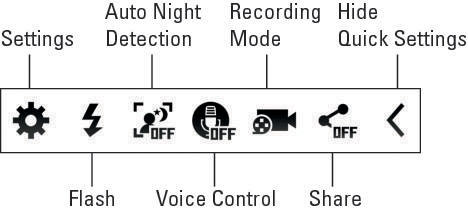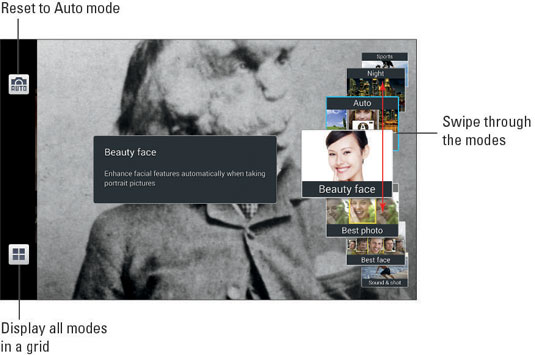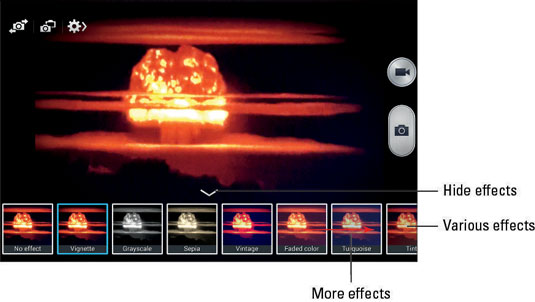The Samsung Galaxy tablet’s camera is much more than just a hole in the case. Taking a picture or shooting a video can involve more than just touching an icon. To help you get the most from the tablet’s camera, various settings, options, and effects eagerly lurk beneath the Camera app’s interface.
How to delete an image immediately after you take it on your Samsung Galaxy tablet’s camera
Sometimes, you just can’t wait to delete an image. Either an irritated person is standing next to you, begging that the photo be deleted, or you’re just not happy and you feel the urge to smash into digital shards the picture you just took. Hastily follow these steps:
Touch the Previous Image rectangle that appears on the Camera app’s screen.
After touching the preview, you see the full-screen image. Videos appear with a Play icon center screen.
Touch the Trash icon.

If you don’t see the Trash icon, briefly touch the screen.
Touch the OK button to remove the image or video.
Touch the Back button to return to the Camera app.
When you desire destruction of more than just the last image you took (or video you recorded), visit the Gallery app.
How to set the flash on your Samsung Galaxy tablet
Not all Galaxy tablets feature a flash on the rear camera. If your tablet does, you can set the flash’s behavior.


| Setting | Icon | Description |
|---|---|---|
| Auto | The flash activates during low-light situations but not when it’s bright out. | |
| On | The flash always activates. | |
| Off | The flash never activates, even in low-light situations. |
To change or check the flash setting, touch the Settings icon on the Camera app screen. After touching the Settings icon, you see the Quick Settings.

The icon for the current flash setting is shown in the lineup, similar to the flash icon. Touch that icon repeatedly to cycle through the three available options.
When the Auto or On flash option is set, that icon appears on the Camera app’s screen. When the flash setting is Off, no icon appears.
To illuminate the subject when shooting video, choose the On setting. The On setting uses a lot of battery power, so use it sparingly.
A good time to turn on the flash is when taking pictures of people or objects in front of something bright, such as a fuzzy brown kitten playing with a ball of white yarn in front of an exploding gasoline truck.
The icons are called the Quick Settings. You can add or remove icons to the list by touching the Menu button and choosing the Quick Settings command.
How to set the image’s location on Samsung Galaxy tablet’s
Your Galactic tablet’s camera not only takes a picture but also keeps track of where you’re located on planet earth when you take the picture — if you’ve turned on that option. Here’s how to ensure that it’s on — or off if you’d rather not let people know where you caught that fish:
While using the Camera app, touch the Menu button.
Choose Settings.
The Settings window appears.
Touch the Settings tab.
It’s called the Settings tab.
Choose Location Tag or GPS Tag.
Different versions of the Camera app call it different things. In fact, it’s rumored that the Galaxy Tab 4 will call it the WhereU@ tag.
Choose On to enable this feature; Off to disable.
You may see an Attention box, explaining the potential peril you face when activating the GPS Tag feature. Touch the OK button after you skip reading the information.
Touch the Back icon to return to the Camera app’s main screen.
When the GPS Tag feature is activated, the GPS icon appears on the Camera’s screen.

How to choose the storage device on your Samsung Galaxy tablet
Images you take and videos you record on your tablet are stored on the primary storage device, also known as internal storage. You can change that location to the microSD card, or external storage. To do so, follow these steps while using the Camera app:
Press the Menu button, and then choose the Settings command.
Touch the Settings tab.
Scroll down to choose the Storage item.
Choose Memory Card to direct the Camera app to use the microSD card for storing images and videos, or choose Device to use internal storage.
When Memory Card is chosen, a memory (SD) card icon appears on the Camera app screen. When internal storage is chosen, the SD card icon doesn’t appear.
How to adjust the Samsung Galaxy tablet’s camera
Two items you can adjust in the Camera app are the shooting mode and visual effects. The shooting mode is handled by the Mode icon. The array of visual effects appears at the bottom of the screen when you touch the Effects chevron.
Shooting mode sets the camera’s behavior. It provides handy shortcuts to solve some typical photo-taking problems. To view the various modes, touch the Mode icon.

When you’ve finished using a specific shooting mode, remember to change the mode back to Auto.
Effects are a series of filters you can apply to the image before you shoot. Touch the chevron at the bottom of the screen to peruse the options.

Each effect has its own wee preview window. Choose an effect, and then take the picture. For example, to capture a grayscale (black-and-white) shot, choose that effect, and then touch the Shutter icon. The effects also apply to shooting video.
To cancel an effect, choose the No Effect option.





